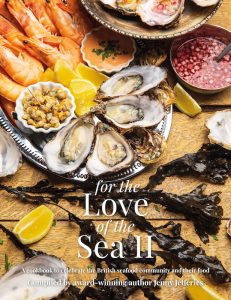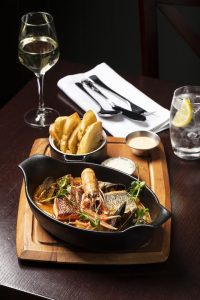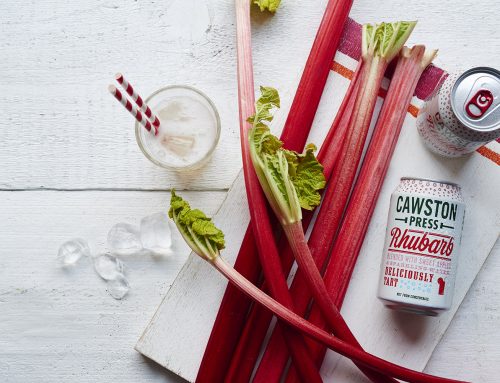I have to confess that I missed the first book by Jenny Jefferies, but it was an award-winning culinary tome, and I strongly suspect its sequel will follow suit. For the Love of the Sea II has recently been published by Meze Publishing and it’s a lovely hardback cookbook that celebrates our British seafood community and its food.
The book has been hailed by chefs such as Mitch Tonks of Rockfish as a ‘seafood odyssey’. It certainly is: you, the reader will travel along our shores, discovering stories and recipes from fishmongers to basket weavers. It’s also an ideal guide to finding your next destination restaurant and even includes Scott’s in Richmond (as well as far flung locations such as The Isle of Mull).
A central theme is also advocacy for sustainability and education, such as the ‘Fish in Schools Hero’ programme, run by The Food Teachers Centre, introducing youngsters to the delights of cooking with fish and seafood. Jenny is donating 10 percent of her net profits from the sales of this book to The Food Teachers Centre, a charity.

Michelin-starred chef Nathan Outlaw says that author Jenny’s “love of the sea is evident in every page” in his endorsement of the book, a love partly expressed through the host of delicious dishes to try at home.
Combining familiar flavours with fish and seafood in ways that may be new to many readers, recipes include Cockle and Bacon Chowder; Haddock Scotch Egg; Thai Red Curry Mussels; Stargazy Pie; Whelks in Chilli Garlic Butter; Mediterranean Roasted Whole Sea Bass and many more.
For the Love of the Sea II is a true homage to the bounty of Britain’s waters, inviting its readers to celebrate our coastline and the incredible communities who are bound to it. For the Love of the Sea II is a 192-page hardback retailing at £22. It’s available from Amazon, bookshops including Waterstones, and also online from www.mezepublishing.co.uk and www.jennyjefferies.co.uk.
Here are a some recipes to ‘lure you’ (geddit??) into buying the book…
GRILLED MACKEREL WITH BEETROOT, APPLE AND FENNEL SALAD
(from Cornish Sea Salt)
This is a celebration of wintery flavours that marry beautifully with the popular Cornish fish, served with creamed horseradish and tarragon oil. It may look fancy but is very easy to execute and makes a great starter for a dinner party or a light lunch.
2 whole mackerel, butterflied (or 4 fillets)
3 raw or cooked beetroot
2 eating apples (I used Granny Smiths but any variety is fine)

1 small fennel bulb
2 lemons, juiced
5 tbsp extra virgin olive oil
Black pepper, to taste
Cornish Sea Salt Flakes
5-6 sprigs of tarragon
1 clove of garlic, finely chopped
Cornish Sea Salt & Peppery Blend
4 tbsp horseradish
6 tbsp creme fraiche
1 tbsp groundnut or veg oil
To butterfly the mackerel, cut the head off and then cut all the way along from the belly to the tail.
Remove the spine (the easiest way to do this is using scissors) and as many pin bones as possible. Alternatively, ask your fishmonger to butterfly them for you. Now prepare the salad. If you have raw beetroot, roast or boil them whole before removing the skin, which comes off easily once cooked, and cutting into wedges. Prepare the apples by coring and cutting into cubes. Cut the fennel bulb in half and then thinly slice lengthways, preferably using a mandoline, reserving any bright green fronds from the top.
Toss the beetroot, apples and fennel in half the lemon juice and a little olive oil. Season to taste with some cracked black pepper and Cornish Sea Salt Flakes.
Strip the leaves off the tarragon sprigs and chop them finely along with any fennel fronds. Mix these into the remaining lemon juice and olive oil along with the garlic. Season with a pinch of Cornish Sea Salt & Peppery Blend to taste.
In a separate bowl, mix the horseradish and creme fraiche together, then season with a pinch of Cornish Sea Salt Flakes and cracked black pepper.
Once you have prepared the salad, tarragon oil and creamed horseradish, whack your grill to the highest setting and place the mackerel skin side up on a tray, making sure you butterfly it out. Brush the skin with the groundnut or vegetable oil and season generously with Cornish Sea Salt Flakes. Mackerel cooks very quickly so after a maximum of 5-8 minutes under the grill, the skin should start blistering while the underneath steams. Do not turn the mackerel over.
Once the mackerel is ready, assemble your dish by placing your salad onto the plate. Add the mackerel, dot the creamed horseradish around the plate and then drizzle over the tarragon oil.
BOUILLABAISSE (from Fish City, Ballynahinch, Northern Ireland)
‘An iconic Provençal fish soup originally made by Marseillaise fishermen, bouillabaisse derives its abundant flavour from boiling and reducing rockfish in a fragrant broth. At Fish City, we substitute the salmon in this recipe with sustainably sourced sea trout. ‘
1 onion, finely sliced
1 white leek, finely sliced
1 stick of celery, finely chopped 
1 fennel bulb, finely sliced
45ml olive oil
250ml white wine
2 bay leaves
1 sprig of thyme
1 star anise
1 orange, zested
Pinch of saffron
1.5 litres fish stock
500g tinned chopped tomatoes
35ml Pernod
1 mackerel fillet, cut into 4 pieces
4 x 80g salmon fillets
4 large langoustines
12 mussels
1 fresh baguette
5 cloves of garlic
Sweat off all the vegetables in the olive oil until soft.
Add the wine, herbs, star anise, orange zest, and saffron to the pan. Reduce the liquid by 75%.
Add the fish stock and chopped tomatoes to the pan, then cook over a gentle heat for 2 hours.
Remove the pan from the heat and add the Pernod, then season with salt and pepper to taste.
Pan fry the mackerel and salmon, then add the langoustines so that everything finishes cooking at the same time. Meanwhile, cook the mussels in the bouillabaisse until they open.
To make the garlic croutes, cut the baguette into 1cm slices, rub with olive oil and a garlic clove, then bake in the oven at 180°c for 4-5 minutes.
Serve the bouillabaisse with your garlic croutes and some red pepper aioli
LOBSTER LINGUINE (Crabpotcellars, Hope Cove, Kingsbridge, Devon)
‘This recipe originated to use up leftover lobster or crab from a seafood salad meal for guests, David having brought in more than we needed from the boat. This recipe succeeds either by ‘stretching’ small amounts of shellfish or being rather more generous depending on what you have to hand. ‘
1 lobster, cooked and picked (15 minutes boiling for 750g, 20 minutes for 1kg)

500g fresh or dried linguine or tagliatelle
1 tbsp olive oil
Knob of butter
1 onion, finely chopped
1-2 spring onions, thinly sliced
1 clove of garlic, or to taste
1 medium heat chilli, deseeded and finely chopped (optional)
1 tin of chopped tomatoes, or the equivalent amount of fresh, fleshy tomatoes, roughly chopped
2 tbsp dry vermouth, wine or brandy
100ml fish stock (optional)
100ml cream
Fresh basil, chopped (leave some leaves whole for garnish)
Salt and pepper
Dice the picked lobster meat and set aside. The coral or eggs are good in this dish because of their bright red colour.
If your pasta is dried, get a pan of salted water boiling and drop in the linguine or tagliatelle to cook for 10 minutes.
Meanwhile, start the sauce by heating the oil and butter. Fry the onions and garlic until softened but not browned, then add the chilli, tomatoes and vermouth.
Simmer the sauce for 10 minutes, adding the fish stock if desired for a looser consistency. Once simmered, stir in the cooked lobster for just long enough to heat through – do not overcook it.
If you are using fresh pasta, drop it into a pan of boiling salted water now to cook for 2 minutes. Add the cream and basil to the lobster sauce, then season with salt and black pepper to taste.
Pour the finished lobster sauce over the drained pasta in bowls or toss them together before serving. Garnish with the reserved basil leaves and enjoy.




